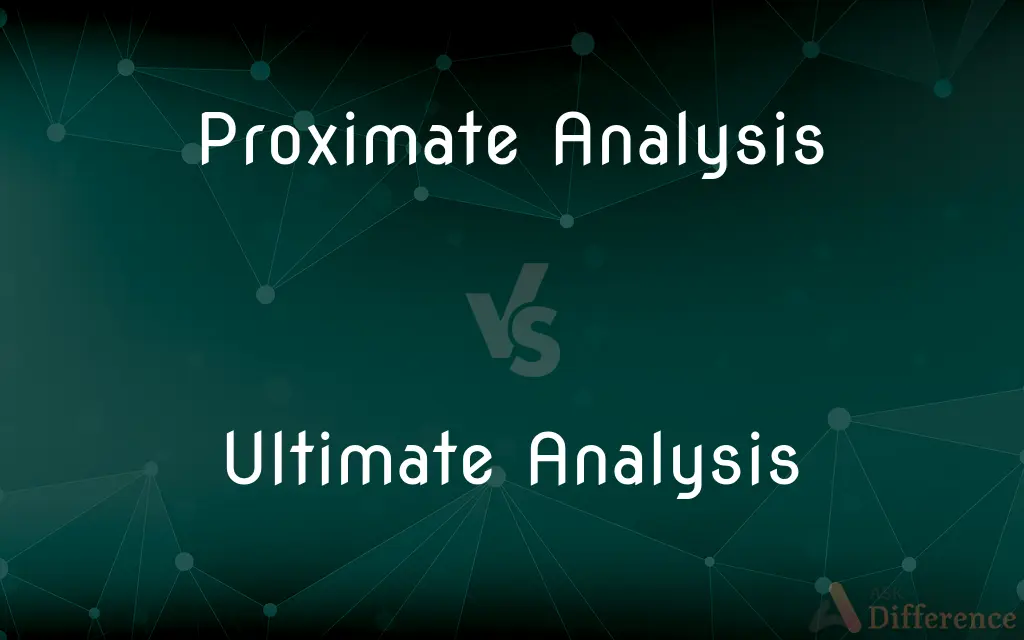Proximate Analysis vs. Ultimate Analysis — What's the Difference?
Edited by Tayyaba Rehman — By Fiza Rafique — Published on December 20, 2023
Proximate Analysis determines moisture, volatile matter, ash, and fixed carbon in fuels; Ultimate Analysis quantifies elemental composition, e.g., carbon, hydrogen, sulfur.

Difference Between Proximate Analysis and Ultimate Analysis
Table of Contents
ADVERTISEMENT
Key Differences
Proximate Analysis is a standardized method used primarily to analyze the moisture, volatile matter, ash, and fixed carbon content in coals and solid fuels. In contrast, Ultimate Analysis provides detailed information on the elemental composition, typically carbon, hydrogen, nitrogen, sulfur, and oxygen.
When considering fuel evaluation, Proximate Analysis gives a quick overview of the fractions that can be burned to produce energy and the residues that remain. Ultimate Analysis, on the other hand, breaks down the fuel's elemental composition, shedding light on its potential heat value and environmental impact.
From an environmental perspective, Proximate Analysis allows determination of ash content, which might contribute to slagging and fouling in boilers. In contrast, Ultimate Analysis can indicate the sulfur content, vital for understanding potential sulfur dioxide emissions when the fuel is burned.
Laboratories conducting Proximate Analysis use a series of steps including drying the sample, measuring volatile materials, and determining ash content. In Ultimate Analysis, sophisticated instruments, such as a CHNS/O analyzer, are typically employed to determine the fuel's elemental composition.
While both analyses provide crucial data for fuel assessment, Proximate Analysis tends to be quicker and less detailed than Ultimate Analysis, which offers a more profound understanding of the material's chemical makeup.
ADVERTISEMENT
Comparison Chart
Main Focus
Moisture, volatile matter, ash, fixed carbon
Elemental composition (C, H, N, S, O)
Used For
Evaluating burnable fractions and residues
Assessing potential heat value and environmental impact
Environmental Significance
Determines ash content for slagging/fouling potential
Determines sulfur content for potential SO2 emissions
Methodology
Series of steps including drying and measuring
Often uses CHNS/O analyzer
Level of Detail
Provides a quick overview
Offers detailed elemental composition
Compare with Definitions
Proximate Analysis
Useful for understanding potential residues after burning.
Using Proximate Analysis, they assessed the slagging potential of the biomass.
Ultimate Analysis
Often involves sophisticated instruments like CHNS/O analyzers.
The lab used a CHNS/O analyzer for the Ultimate Analysis of the sample.
Proximate Analysis
Gives an overview of burnable fractions and residues.
Proximate Analysis helps understand the energy potential of solid fuels.
Ultimate Analysis
A more detailed technique compared to Proximate Analysis.
To get a comprehensive fuel evaluation, they preferred Ultimate Analysis.
Proximate Analysis
Commonly used for coal and solid fuel testing.
Every batch of coal undergoes Proximate Analysis before utilization.
Ultimate Analysis
Frequently used to analyze carbon, hydrogen, nitrogen, sulfur, and oxygen content.
The Ultimate Analysis revealed the biomass's elemental composition.
Proximate Analysis
A method to evaluate moisture, volatile matter, ash, and fixed carbon in fuels.
The Proximate Analysis of the coal sample showed a high ash content.
Ultimate Analysis
Determines the elemental composition of a sample, often fuels.
The Ultimate Analysis showed a high sulfur content in the coal sample.
Proximate Analysis
A quick but less detailed fuel assessment technique.
For a rapid fuel assessment, they opted for a Proximate Analysis.
Ultimate Analysis
Essential for assessing potential heat value and environmental impact.
Through Ultimate Analysis, they predicted the heating value of the biofuel.
Common Curiosities
Which analysis is more detailed?
Ultimate Analysis provides a more detailed elemental breakdown than Proximate Analysis.
Which analysis provides a quicker overview, Proximate or Ultimate?
Proximate Analysis offers a faster overview compared to Ultimate Analysis.
Is Ultimate Analysis crucial for environmental assessments?
Yes, Ultimate Analysis helps determine elements like sulfur, which can impact environmental emissions.
What does Proximate Analysis primarily determine in coal?
Proximate Analysis primarily assesses moisture, volatile matter, ash, and fixed carbon in coal.
Why is ash content important in Proximate Analysis?
Ash content, determined by Proximate Analysis, indicates potential residues and slagging/fouling potential.
Can Proximate Analysis reveal sulfur content?
No, sulfur content is typically determined through Ultimate Analysis.
Can Ultimate Analysis determine the caloric value of a fuel?
Yes, the elemental composition from Ultimate Analysis can be used to estimate the caloric value.
Is Ultimate Analysis used for solid fuels only?
No, Ultimate Analysis can be used for both solid and liquid fuels.
Does Proximate Analysis require advanced instruments?
Proximate Analysis uses standard laboratory methods, while Ultimate Analysis may require more advanced instruments.
Are specialized instruments needed for Ultimate Analysis?
Yes, Ultimate Analysis often requires instruments like CHNS/O analyzers.
Which analysis provides a better understanding of combustion residues?
Proximate Analysis gives insights into potential residues after combustion.
Why is volatile matter significant in Proximate Analysis?
In Proximate Analysis, volatile matter indicates the portion of fuel that can vaporize when heated.
Can both analyses be used for biomass fuels?
Yes, both Proximate Analysis and Ultimate Analysis can be applied to biomass fuels.
Can Ultimate Analysis help in assessing greenhouse gas emissions?
Yes, Ultimate Analysis provides elemental data, aiding in estimating potential greenhouse gas emissions.
What's the main purpose of Proximate Analysis?
Proximate Analysis evaluates the moisture, volatile matter, ash, and fixed carbon in fuels, aiding in fuel assessment.
Share Your Discovery

Previous Comparison
Behaviorism Psychology vs. Cognitive Psychology
Next Comparison
Pumps vs. StilettosAuthor Spotlight
Written by
Fiza RafiqueFiza Rafique is a skilled content writer at AskDifference.com, where she meticulously refines and enhances written pieces. Drawing from her vast editorial expertise, Fiza ensures clarity, accuracy, and precision in every article. Passionate about language, she continually seeks to elevate the quality of content for readers worldwide.
Edited by
Tayyaba RehmanTayyaba Rehman is a distinguished writer, currently serving as a primary contributor to askdifference.com. As a researcher in semantics and etymology, Tayyaba's passion for the complexity of languages and their distinctions has found a perfect home on the platform. Tayyaba delves into the intricacies of language, distinguishing between commonly confused words and phrases, thereby providing clarity for readers worldwide.












































